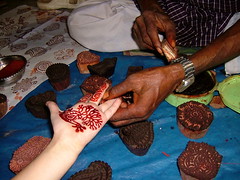M is for MEHENDI
The art of Mehendi has existed for centuries. The exact place of its origin is difficult to track because of centuries of people in different cultures moving through the continents and taking their art forms with them and therefore sharing their art with everyone along the way.
Some historical evidence suggests that Mendhi started in India while others believe it was introduced to India during the twelfth century A.D.
Proof has been found that henna (MEHENDI) was used to stain the fingers and toes of Pharoahs prior to mummification over 5000 years ago when it was also used as a cosmetic and for it's healing power.
The henna used for Mehendi comes from a bush called Lawsonia Inermis which is part of the loose strife family and is grown in the Sudan, Egypt, India, most of the North African counties, The Middle East and other hot and dry places. . The lance- shaped leaves from the bush are harvested, dried and then crushed to make the henna powder. Henna is used for hair dye, as a skin conditioner and as a reliever for rashes. The art of mehendi is referred to as henna or mehendi depending on where you are and which name you feel came first.
Mehendi designs have traditionally fallen into four different styles. The Middle Eastern style is mostly made up of floral patterns similar to the Arabic textiles, paintings and carvings and do not usually follow a destinctive pattern. The North African style generally follows the shape of the hands and feet using geometrical floral patterns. The Indian and Pakistani designs encompass more than just the feet and hands and generally extend further up the appendages to give the illusion of gloves and stockings which are made up of lines, paisley patterns and teardrops. Lastly, the Indonesian and Southern Asian styles were a mix of Middle Eastern and Indian designs using blocks of color on the very tips of their toes and fingers.
In some Indian cultures, it is used at celebrations like weddings and other special occasions which are traditionally associated with transcendence and transformation. It is used for worship and work but not for the sake of vanity. It is traditional for the bride to get together with her friends and have them spend hours applying the henna to her skin and give her marriage advice in tandem. The patterns used for weddings are generally very intricate and time consuming.
However, there is a quick method that unfortunately does not use natural dyes but still creates a beautiful stain. Wooden blocks are used to apply the designs in a matter of seconds...street fair fun.
Some historical evidence suggests that Mendhi started in India while others believe it was introduced to India during the twelfth century A.D.
Proof has been found that henna (MEHENDI) was used to stain the fingers and toes of Pharoahs prior to mummification over 5000 years ago when it was also used as a cosmetic and for it's healing power.
The henna used for Mehendi comes from a bush called Lawsonia Inermis which is part of the loose strife family and is grown in the Sudan, Egypt, India, most of the North African counties, The Middle East and other hot and dry places. . The lance- shaped leaves from the bush are harvested, dried and then crushed to make the henna powder. Henna is used for hair dye, as a skin conditioner and as a reliever for rashes. The art of mehendi is referred to as henna or mehendi depending on where you are and which name you feel came first.
Mehendi designs have traditionally fallen into four different styles. The Middle Eastern style is mostly made up of floral patterns similar to the Arabic textiles, paintings and carvings and do not usually follow a destinctive pattern. The North African style generally follows the shape of the hands and feet using geometrical floral patterns. The Indian and Pakistani designs encompass more than just the feet and hands and generally extend further up the appendages to give the illusion of gloves and stockings which are made up of lines, paisley patterns and teardrops. Lastly, the Indonesian and Southern Asian styles were a mix of Middle Eastern and Indian designs using blocks of color on the very tips of their toes and fingers.
In some Indian cultures, it is used at celebrations like weddings and other special occasions which are traditionally associated with transcendence and transformation. It is used for worship and work but not for the sake of vanity. It is traditional for the bride to get together with her friends and have them spend hours applying the henna to her skin and give her marriage advice in tandem. The patterns used for weddings are generally very intricate and time consuming.
However, there is a quick method that unfortunately does not use natural dyes but still creates a beautiful stain. Wooden blocks are used to apply the designs in a matter of seconds...street fair fun.


0 Comments:
Post a Comment
Subscribe to Post Comments [Atom]
<< Home